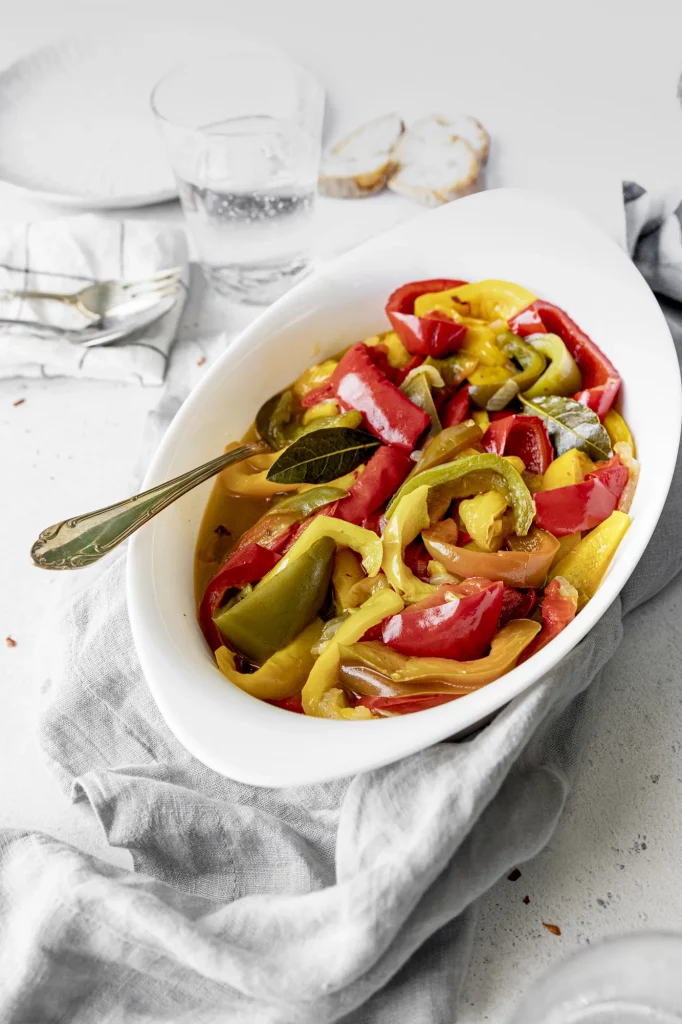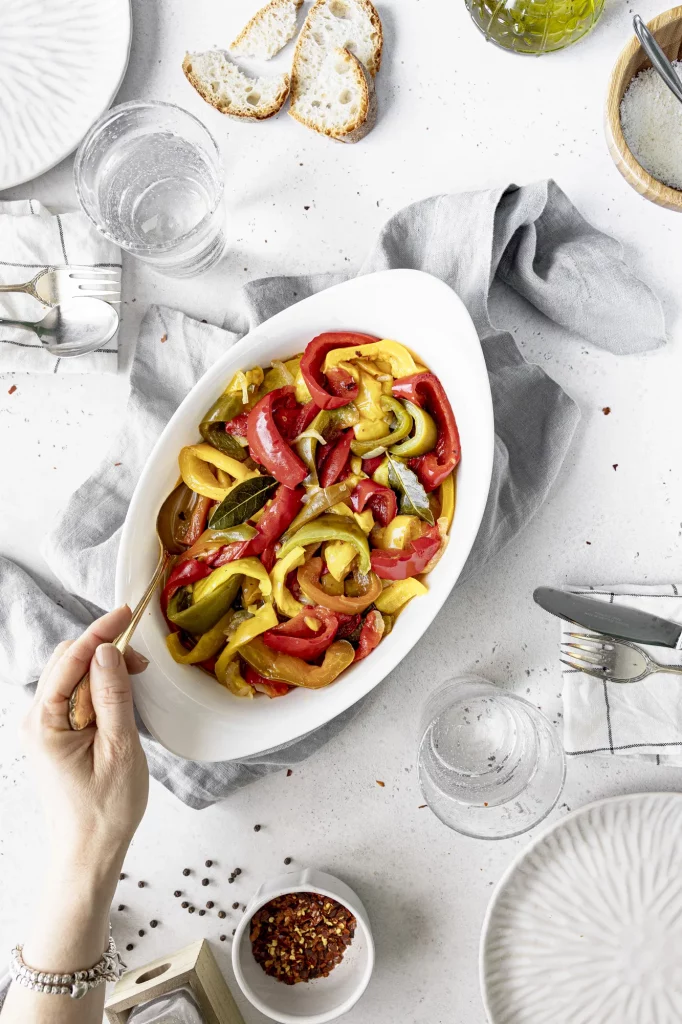Nothing says Italy more than a caponata that embraces the most typical flavors of southern Italy, most notably Sicily. The wonderful ingredients form the cornerstone of Sicilian cooking—eggplant, olives, tomatoes—while producing a host of tempting flavors.

Caponata is not an ordinary side at all
Its sweet and sour taste makes this side different from any other vegetable dish in Italy.
It takes just a little preparation to bring it to your table—creamy and embracing—its scent will conquer your nose, and its unbelievable taste will satisfy your tastebuds.
Its history…
Caponata dates back in time to a rich and varied Sicilian cooking tradition. Rich aristocratic families were served this dish which was composed mainly of fish along with some vegetables. In contrast, peasant families had a poorer version, one composed only of vegetables because fish was too expensive for them. So a vegetable caponata became the dish which we serve today. It is mainly eaten in summer when the eggplant are ripe. Since Sicilian caponata is easy to make, you can bring a genuine taste of Sicily to your table.
What’s caponata?
As with all Italian traditional dishes, every family has their own recipe. I have found plenty of different variations of this recipe and as a result, a lot of people have asked if this one is the authentic caponata. Does it call for basil or mint? Does it call for potatoes or bell peppers? Believe it or not, there are 36 “registered” recipes of caponata which means there are lots of variations. Its sweet and sour flavor gives the dish a really special taste.
Is caponata the same as ratatouille?
Caponata and ratatouille are similar in that they share some of the same ingredients: eggplant, tomatoes, onions. The former is Italian; the latter, French. They are composed of similar vegetables and are similarly cooked in olive oil. Vinegar, olives, capers, and raisins give caponata its unique sweet and sour flavor which make this different from ratatouille.
A thousand variations with similar ingredients
Let’s start with the Agrigento recipe where caponata is made with eggplant, bell peppers, tomatoes, onions, celery, green olives, black olives, capers, vinegar, honey, sugar, garlic, oil, red pepper flakes, basil, pine nuts or almonds, and raisins.
In Trapani, caponata is cooked with eggplant, bell peppers, ripe tomatoes, onions, olives, capers, vinegar, sugar, toasted almonds, and raisins.
In Catania, caponata is made with eggplant, bell peppers of several colors, olives, onions, capers, vinegar, sugar, and sometimes, basil, garlic, and potatoes.
The Messina variation differs from the Palermo version because it calls for peeled plum tomatoes instead of tomato sauce or paste.
I am going to provide the instructions for the last one because it is the tastiest. Make sure to prepare your caponata in plenty of time; you should cook it the day before so that all the flavors combine well together to create this masterpiece. Everybody will appreciate it and offer a thunderous applause.
How can you eat caponata?
It is a side which may be paired with any dishes: meat, fish, eggs, cheese. There are a thousand possibilities. For instance, it makes perfect stuffing for sandwiches, flatbread, or a tempting topping for pizza or toast for bruscetta or friselle. For a genuinely delicious main course try caponata with tuna to season pasta.
One and thousand toothsome recipes
Some ingredients are essential; others vary locally. Common are eggplant, celery, onion, green olives, and capers, and a sweet-sour flavoring: vinegar and sugar or honey together. If you want to make it even sweeter, add two or three spoonfuls of raisins soaked in warm water. The recipe calls for pine nuts, but they may also be replaced with almonds. Basil or mint provide the aromatic scent and taste. Do you want bell peppers? Of course, all colors. Only green olives? You can choose black ones too.
7 essential steps for your perfect caponata
You have to know a few basics to prepare a perfect caponata like the one you would eat in Italy in that nice small restaurant by the sea.
- The eggplant must be fried not sautéed;
- Use vinegar from white or red wine along with sugar or honey for the sweet-sour flavor;
- A lot of recipes call for bell peppers. If you like them, choose one red and one yellow;
- You should cook the celery; otherwise, its taste may prevail over the others. With cooking, it will get softer and less prominent;
- Grated dark chocolate gives caponata a definitely unique taste. Give it a try;
- Cut the olives in half or small pieces; leave the capers whole;
- The vegetables must keep their shape, so stir them with a wooden spoon while cooking. Be careful as this is fundamental.
Sweet and sour Sicilian caponata with eggplants, bell peppers, pine-nuts, and olives
Ingredients
- 2.2 lb of dark eggplant (1 kg)
- 1 big onion
- 1/2 lb of celery (500g)
- 1 tbsp of pine nuts (or peeled toasted almonds) (30g)
- 1 tbsp tomato paste
- 1 small can of tomatoes for sauce OR 2 cups (380g) of very ripe tomatoes diced (400g)
- 1/2 cup of green olives (80g)
- 3 tbsp of salt-cured capers (50g)
- 2 tbsp of extra virgin olive oil
- 5-6 basil leaves or fresh mint
- 1 full tbsp of sugar (or 2 tablespoons of honey, such as acacia or orange blossom honey)
- 2 tbsp of white wine vinegar
- Olive oil for frying; you may also use peanut oil
- Salt and pepper
- Extra: a teaspoon of grated dark chocolate; add it at the end of the cooking
- Extra: a clove of garlic to add when you sweat the onion
Instructions
- Wash and dice the eggplant, but don’t peel them;
- Place the eggplant pieces into a strainer or directly in the kitchen sink;
- Generously sprinkle with salt, and allow them to sit for 1 hour;
- Wash and dice the celery into very small pieces;
- Immerse the celery in boiling water for 2 minutes, drain it while still crisp and save the water as you will need it for the tomatoes;
- Bring the water to a boil again, immerse the tomatoes for 30 seconds, or until the skins start to peel back, and rinse them under cold running water; peel the tomatoes, discard the seeds, and cut them into coarse pieces;
- Toast the pine nuts in a nonstick pan for a few minutes. Stir them so that they don’t burn;
- Halve and pit the olives;
- Sweat the onion (cook them over very low heat until they turn translucent) in a large hot skillet with two tablespoons of oil;
- When the onion turns golden, add the tomatoes and the tomato paste; cook over medium heat without a lid for about 10 minutes;
- Season with salt and pepper and add the celery, the olives, and the capers (rinse away all the salt before using them);
- Cook for about 3-4 minutes;
- Dissolve the sugar in the vinegar. Stir well and pour it on the vegetables;
- Let simmer until reduced;
- Cook over medium-low heat for about 20 minutes until all the flavors are well combined and the sauce gets smooth and thick;
- Rinse the salt off the eggplant in cold running water;
- Pat the eggplant dry with a paper towel;
- Fry the eggplant pieces in plenty of very hot extra virgin olive oil in two or three batches;
- When they turn golden, take them out with a skimmer and place the pieces on a tray lined with a paper towel in order to remove the excess oil;
- When you have fried all the eggplant, add the pieces to the other vegetables; stew over low heat for 5 minutes;
- Add the toasted pine nuts;
- Wash and add the basil leaves;
- Stir well and cook for a few more minutes so that they absorb all the flavor;
- Garnish with some basil leaves and pine nuts and enjoy your caponata.
How can you keep caponata?
Caponata is best eaten at room temperature and sprinkled with chopped basil. It keeps fresh up to 2 or 3 days in an airtight container in the fridge. It gets even tastier as it absorbs the flavors. Take it out of the fridge at least one hour before serving.

